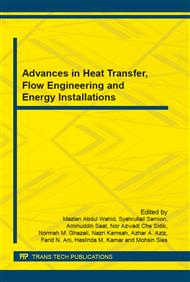[1]
http: /www. citypopulation. de.
Google Scholar
[2]
T.F. Stocker, D. Qin, G. -K. Plattner, M. Tignor, S.K. Allen, J. Boschung, A. Nauels, Y. Xia, V. Bex, P.M. Midgley, IPCC, 2013: Summary for Policymakers. In: Climate Change 2013: The Physical Science Basis. Contribution of Working Group I to the Fifth Assessment Report of the Intergovernmental Panel on Climate Change, Cambridge University Press, Cambridge, United Kingdom and New York, NY, USA (2013).
DOI: 10.1017/cbo9781107415324.004
Google Scholar
[3]
S.A. Klein, TRNSYS 17: A Transient System Simulation Program, Solar Energy Laboratory, University of Wisconsin, Madison, USA, http: /sel. me. wisc. edu/trnsys (2010).
Google Scholar
[4]
M. Sivak, Potential energy demand for cooling in the 50 largest metropolitan areas of the world: Implications for developing countries. Energy Policy, 37 (2009) 1382-1384.
DOI: 10.1016/j.enpol.2008.11.031
Google Scholar
[5]
C. Li, Y. Goswami, E. Stefanakos, Solar assisted sea water desalination: a review, Renewable and Sustainable Energy Reviews 19 (2013) 136–163.
DOI: 10.1016/j.rser.2012.04.059
Google Scholar
[6]
A.M. Alklaibi, N. Lior, Membrane-distillation desalination: status and potential, Desalination 171 (2004) 111-131.
DOI: 10.1016/j.desal.2004.03.024
Google Scholar
[7]
A.M. Alklaibi, N. Lior, Transport analysis of air-gap membrane distillation, Journal of Membrane Science 255 (2005) 239-253.
DOI: 10.1016/j.memsci.2005.01.038
Google Scholar
[8]
J.P. Mericq, Approche intégrée du dessalement d'eau de mer : Distillation membranaire sous vide pour la réduction des rejets salins et possibilités de couplage avec l'énergie solaire, Thèse de doctorat, INSA de Toulouse, France (2009).
DOI: 10.5150/cmcm.2017.018
Google Scholar
[9]
C. Charcosset, A review of membrane processes and renewable energies for desalination, Desalination 245 (2009) 214–231.
DOI: 10.1016/j.desal.2008.06.020
Google Scholar
[10]
P. Byrne, J. Miriel, L. Serres, R. Ghoubali, Etude simulée d'un système de dessalement d'eau de mer et de production de froid par thermofrigopompe couplée à des panneaux solaires, 2ème Colloque International Francophone en Energétique et Mécanique, CIFEM 2012, Ouagadougou, Burkina Faso (2012).
DOI: 10.18006/2015.3(3).288.297
Google Scholar
[11]
P. Byrne, Y. Ait Oumeziane, L. Serres, J. Miriel, Etude simulée d'un système de distillation membranaire pour le dessalement d'eau de mer couplé à une thermofrigopompe, 3ème Colloque International Francophone en Energétique et Mécanique, CIFEM 2014, Moroni, Comores (2014).
Google Scholar
[12]
P. Byrne, J. Miriel, Y. Lenat, Design and simulation of a heat pump for simultaneous heating and cooling using HFC or CO2 as a working fluid, International Journal of Refrigeration 32 (2009) 1711-1723.
DOI: 10.1016/j.ijrefrig.2009.05.008
Google Scholar
[13]
P. Byrne, J. Miriel, Y. Lenat, Experimental study of an air-source heat pump for simultaneous heating and cooling – part 1: basic concepts and performance verification, Applied Energy 88 (2011) 1841-1847.
DOI: 10.1016/j.apenergy.2010.12.009
Google Scholar
[14]
P. Byrne, J. Miriel, Y. Lenat, Experimental study of an air-source heat pump for simultaneous heating and cooling – part 2: dynamic behaviour and two-phase thermosiphon defrosting technique, Applied Energy 88 (2011) 3072-3078.
DOI: 10.1016/j.apenergy.2011.03.002
Google Scholar
[15]
P. Byrne, J. Miriel, Y. Lenat, Modelling and simulation of a heat pump for simultaneous heating and cooling, Building Simulation: An International Journal 5 (2012) 219–232.
DOI: 10.1007/s12273-012-0089-0
Google Scholar
[16]
P. Byrne, R. Ghoubali, J. Miriel, Scroll compressor modelling for heat pumps using hydrocarbons as refrigerants, International Journal of Refrigeration, International Journal of Refrigeration 41 (2014) 1-13.
DOI: 10.1016/j.ijrefrig.2013.06.003
Google Scholar
[17]
R. Ghoubali, P. Byrne, J. Miriel, F. Bazantay, Simulation study of heat pumps for simultaneous heating and cooling coupled to buildings, Energy and Buildings 72 (2014) 141-149.
DOI: 10.1016/j.enbuild.2013.12.047
Google Scholar
[18]
F.A. Banat, Membrane distillation for desalination and removal of volatile organic compounds from water, Doctoral Thesis, McGill University, Montreal, Canada (1994).
Google Scholar


